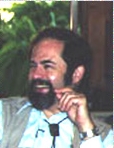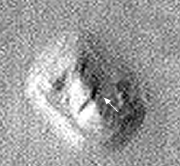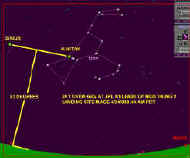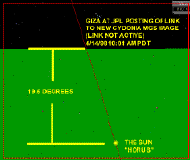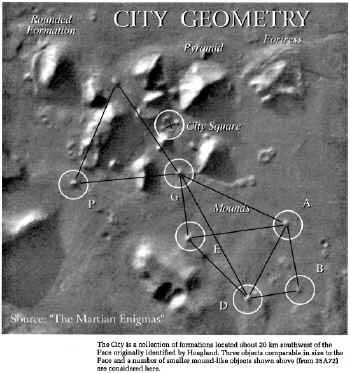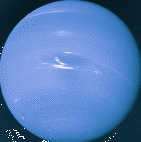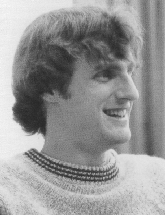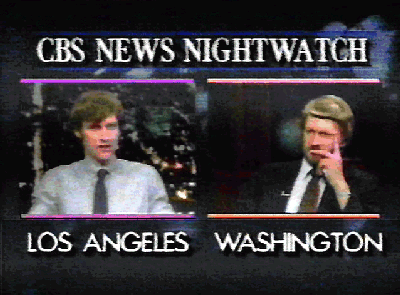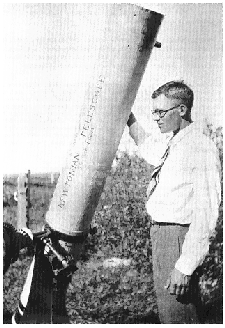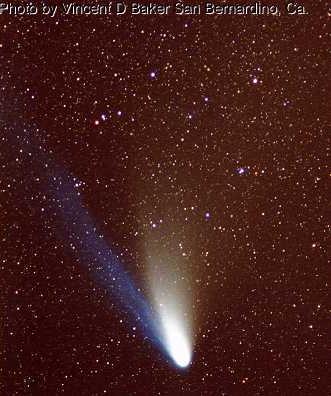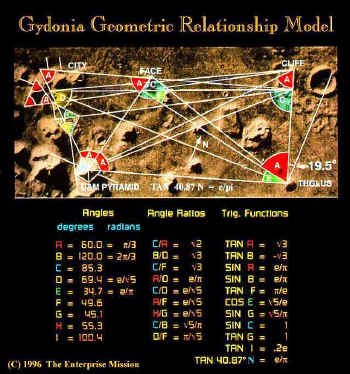Orwell and the Internet
or
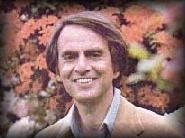
| "The question is not whether you are right or wrong, sir. You
are not even in the conversation" - Dr. Carl Sagan to Dr. John Brandenberg regarding Brandenberg's work on Cydonia. |
by
Mike Bara
| Dr. Sagan's infamous response to the evidence presented to him regarding
the Face and other anomalies at Cydonia is indicative of a pervasive and exclusionary
attitude from the planetary science community. No one "outside the club" is
permitted to have an opinion or even to present an argument on the major issues of the
day, unless they have been anointed by the powers that be. We see this pedantic approach recurring in all areas of academic endeavor, from the traditional Egyptologists response to the work of John Anthony West, Robert Schoch and Graham Hancock, to the a-priori rejection of tests proposed by Dr. Peter Duesberg regarding the HIV virus. Even in the careful, considered alteration of data by the Physics staff at M.I.T. from their Cold Fusion experiments. [1] It is conceivable to envision a scenario where this may be good thing. Honorable and educated scientists setting the rules for the good of the process and in pursuit of the ultimate truths that surround us. But in reality, planetary scientists are no more honorable, no less beholden to political or monetary agendas, and no less attached to pet theories and bad science than the great unwashed masses they seek to "enlighten" with their proclamations. |
The fierce competition for pieces of an ever shrinking pie of research grants can and has lead to the promotion of an established theory over a newer and possibly more valid one. Given that the grants doled out by NASA and other agencies are the basis for mortgage payments and shoes for the kids, it is not surprising that scientists have been willing to claim credit for the prior work of others in an effort to gain favor with the elite holding the purse strings.

What we have always had as a hedge against such an usurpation of the history is an established process of discovery - the record in the Scientific Journals. The axioms "publish or perish" and "he who publishes first gets the credit" have ensured a paper trail of invention over the centuries, providing a foundation upon which the search for truth can be buttressed. While there is nothing in the Scientific Method requiring publication in such journals, it has always been accepted that this is the only logical way to resolve issues of precedence and therefore credibility. [2]
The counterpoint to this perspective - and the danger - is that this "peer review" process can become a closed society, as segregated as the suburban country clubs of the deep South, pressing it's members to conform to the current orthodoxy rather than pursuing independent and creative science. After all, if "Hot Fusion" is the current cash cow for the Physics department at M.I.T., it isn't likely that cheap power through "Cold Fusion" is going to get a fair hearing, especially when the idea is broached by a couple of chemists from outside the Physics "Club". In fact, as Physicist Max Planck once noted, the only way a new idea takes hold in science is when the advocates of the old idea die off.
Recently, however, there has been a new medium exerting a great influence over this process. The Internet is a major threat to the Guilded cloister of the "peer reviewed journals" by providing an outlet for ideas rejected - not on their merits - but perhaps because of the jeopardy in which they place established careers and well funded laboratories.
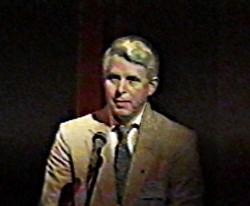
Without the net, the ideas of many innovative scientists like Dr. Tom Van Flandern (above) would simply not be heard. The crushing pressure exerted by this "current orthodoxy" [3] regarding cometary origins has pushed him out of the so-called "mainstream," despite a Ph.d from Yale and a distinguished 3-decade-long career. The Internet has given him an opportunity that flatly did not exist 5 years ago, the chance to go over the heads of the closed Science community and take his ideas directly to the world.
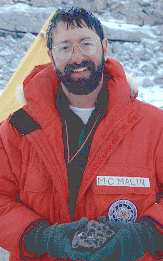 |
But, as we have seen recently, web sites can misuse the truth as easily as
they can expose it. From Michael Malin's placement of deliberately distorted images of the Face on Mars on his web site in a vain attempt to debunk it, to the spurious rewriting of the history of the Cydonia investigation, truth is under assault. [4] While Malin's forgery is easily exposed and swiftly discredited, it reinforces the inherent prejudices so blatantly expressed by Dr. Sagan above. The planetary science community clearly does not welcome new concepts readily. One gets the sense in fact, that Sagan had appointed himself to the post of Discoverer of Life Elsewhere. It would be bad enough to cede that territory to another member of the club, but clearly, no one from outside would be allowed to step in and take such a glorious mantle from the Astrophysics professionals. Perhaps this was the motivation for his masterpiece of disinformation published in Parade magazine in 1985, in which he turned his back on friends and broke many promises. [5] |
|
It would be easy - even desirable - to write these events off to simple resentments or general ignorance. The truth however, is that both men were well educated and briefed on this subject, and have instead chosen to engage in carefully planned campaigns to obfuscate the facts and deflect the attentions of the general public from the enlightening possibilities represented by the Martian Monuments.
Malin, in fact, has gone far beyond that. While professing to be just a "Regular guy" and generally disinterested in "far out" subjects like the Face, he has at the same time orchestrated an elegant orbital dance involving the celestial icons of ancient Egypt.
| Just as we have seen during the days of Apollo, spacecraft are apparently being guided not by practical matters of gravitational fields and orbital librations, but by a desire to be in a certain place and time. [6] | 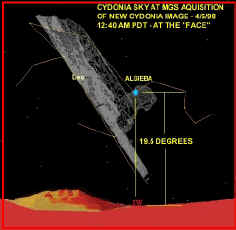 |
Repeatedly, at key moments during the acquisition and release of the recent MGS images of the "Face" and "City" at Cydonia, we find that the primary astronomical figures in Egyptian religion are at key latitudes. |
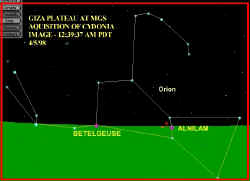 |
Whether on the horizon, at the tetrahedral "19.5 º" latitude, or the "Masonic" 33 º (symbolic of the highest level of enlightenment), Malin has made sure that the gods of the Nile are honored. | 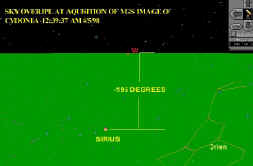 |
| The odds that any one of these events could occur by chance are
"astronomical". But the chances of "Isis/Sirius",
"Osiris/Orion" and "The Sun/Horus" appearing over and over are
incalculable. Even NASA's own mission planners, masters of "Celestial Mechanics" have admitted these cannot be coincidental occurrences. [7] |
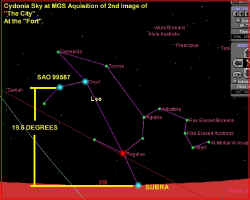 |
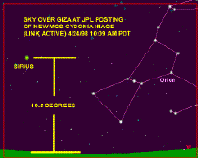 |
|
This bizarre tradition is an ominous thread running through almost the entire history of NASA, and speaks of hidden agendas and a less than honest telling of the real objectives of a space program we have paid for. That Malin pretends on one hand to be a straightforward man of science, but in his private offices practices occult rites of unknown origin and intent, is a fierce indictment of his motives vis-a-vis the Face.

"History, Sir, will tell lies as usual"
- George Bernard Shaw, The Devil's Disciple
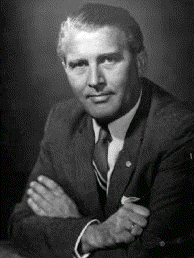 |
Unfortunately, this is hardly an isolated occurrence in NASA's nearly 40 year existence. The agency's history is replete with such strange coincidences and untold stories. |
| The most disturbing of those is the history of one Werner Von Braun, a
"hero" of the American space program, largely credited as the single most
important figure in the Moon program of the 1960's. Without him, there might not have been
a Saturn 5 to carry American astronauts to the Moon. Von Braun is rarely mentioned these
days, and when he is, he is usually portrayed as either a dedicated scientist or a lovable
buffoon, as in "The Right Stuff". But as Shaw says, history tells lies, and the history of Von Braun and the "American" space program is altogether different than has been represented over the decades. |
 |
||
Werner Von Braun (second from right) and pals tour the Nazi rocket facility at Peenemünde. Between 7,000 and 20,000 slave laborers were worked to death at various German rocket facilities during the war. |
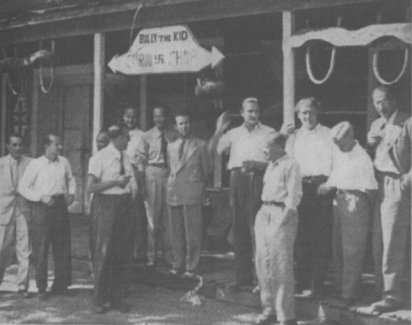 |
||
| Von Braun (third from left) in Nevada after the war. Note the swastika on the sign. He and his friends made no attempt to hide their allegiances while working on "our" space program. |
If this alone does not chill you, consider the following: Von Braun was far more than just a "German rocket scientist" or a mere "Nazi". Documents obtained by TEM researchers show he was nothing less than a Major in Hitler's "SS", the fearsome and fanatically loyal arm of the Nazi war machine entrusted to carry out the most inhuman acts of the regime.[8] That such a man could spend his later years standing next to presidents at medal presentations and giving speeches on the wonders of space exploration, rather than rotting in prison where he belonged, is a testament to the political realities of the cold war.
All of which goes to show that for the right price, NASA and other agencies are willing to bow to political agendas and sweep truth under the nearest rug.
|
"I'm part of an organization that predicts the future. And we have found that the best way to predict the future, is to invent it." - The Well Manicured Man from "The X-Files". |
We are living in a time now were such rewriting of history is remarkably easy. If you desire to "invent" a future, one of the most effective ways to do so is to tell lies about the past.
It seems that someone out there doesn't want you to listen to Richard Hoagland. To discourage you from doing so, there is an apparently well orchestrated Orwellian revision of the past taking place.
SPSR, a Stanley McDaniel led group of self-proclaimed "serious" Cydonia researchers, has recently presented a new publication called "The Case for the Face". In it, a series of papers is presented building on Hoagland's work. While Hoagland is occasionally referenced, he is not addressed directly in any meaningful manner and was not invited to present a paper for the book. How a "Case for the Face" can be made without Mr. Hoagland is a challenge to the imagination. Maybe Hoagland's recent work makes them uncomfortable. Maybe they don't want to admit to themselves that NASA has manipulated various manned and unmanned missions in the manner accomplished by Malin. Maybe they want to think that NASA is an open, honest, civilian science agency and Hoagland is a constant reminder that it is not. [9]
Maybe.
Besides the snub from former colleges, most of whom would not even be involved in Cydonia research were it not for Hoagland, there is another assault against the truth popping up on the internet.
Recent exchanges on internet "UFO" forums have led to this startling proclamation from various posters - Richard Hoagland not only did not discover the "City" at Cydonia, he did not do any computations or papers on the subject. [10]
The truth of course, is somewhat different. Not only did Hoagland "discover" the City and Fortress, he named them as well. [11]
In addition, most of the original work regarding the alignments of the various Cydonia Anomalies and the strategic placement of Horace Crater's "tetrahedral mounds" was done by Hoagland. Later, he and Erol Torun collaborated on "The Message of Cydonia" a huge document laying the foundations for the "Relationship Model" now currently used in AOC hypothesis. [12]
This paper also contained a startling prediction based on the "Hyperdimensional Physics" derived from this ground breaking work -- that Neptune's magnetic field polarity would be anchored at the southern pole, and that various "disturbances", on Neptune and elsewhere, would be centered at or very near the "tetrahedral latitude" -- of 19.5 º.
|
Both these observations proved correct. |
How such well established facts can be so overtly misused is a testament to the obfuscatory power the Internet provides to latecomers who haven't done their homework. Perhaps it should be expected and even forgiven that such amateurs could abuse the truth in this way. It is from the supposedly scholarly community of planetary sciences and mathematicians that we should expect more.
What we expect, and what we get, are sadly two different things.
Scientific credibility and credentials are what is at issue here. Redefine the history of a man's work, and you can control the impact he can make on a future you wish to create.
Besides his substantial work on the Cydonia Anomalies, Richard Hoagland is best known for one other major piece of research.
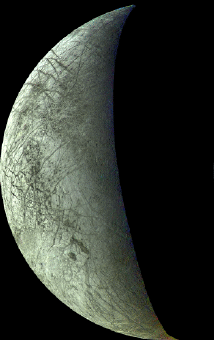 |
The "Europa Proposal". In this lengthy document first published back in 1980, Hoagland laid out in "excruciating" detail his ideas about the probable origin of Euorpa's dark "cracks". Building from earlier work [13] Hoagland wove together an elegant pattern of fact and informed speculation to propose the mechanism by which Europa's "global" ocean (then just a much discounted idea among planetary scientists) could have harbored and nurtured life from the very dawn of the Solar System. Recent data from the Galileo probe has now confirmed much of what Hoagland first proposed nearly 19 years ago. There's only one problem. He's not getting credit for it. |
|
In a truly Orwellian turn of events, efforts are being made to not only
minimize Hoagland's precedence in the Journalistic record, but via the Internet, perhaps
to expunge him from the history completely. The "Point Man" for these efforts is none other than the person most singularly to benefit from the successful execution of the plan. A certain Dr. Steven Squyres. |
|
| By the time he stood up at the July 18th, 1996 Meeting of the
Committee for Space Research and attempted to take credit for Hoagland's work on Europa,
Squyres had already shown a penchant for stretching the truth and certainly had a personal
motivation for minimizing Hoagland's contribution.
In 1988 Squyres had faced off against Hoagland in a nationally televised debate on the Cydonia anomalies and by all accounts was absolutely plastered even before being forced to admit he had never actually looked at any images of the region. [14] When his latest bluff was called by Hoagland in an Enterprise Mission press release, Squyres responded via e-mail to an irate citizen with feeble excuses and Orwellian doublespeak. [15] Initially, Squyres was righteously indignant at being called a "plagiarist" by the writer of the e-mail. He answered by claiming that his invited presentation concerned only the geophysics of tidal stresses on Europa and how they might affect the possibility of a speculated planetary ocean. He emphasized that the subject of possible life there was not in his presentation, and was mentioned only in passing in a few interviews which he somewhat reluctantly participated in. He went on to accuse the press of sensationalizing accounts of his statements, and Hoagland of making charges without actually having viewed the presentations or interviews (somewhat ironic!). Squyres then trips over his own lie in the last paragraph of his e-mail. " ... people should not make or accept claims of plagiarism that are based on a news report about what was said during an invited review talk at a conference." [emphasis mine - M.B.] While claiming simultaneously that his controversial statements concerning life on Europa were made during later interviews, he admits that in fact they were during his actual presentation. His account is also plainly at odds with news reports which imply that the subject of life was part of his actual presentation. These same news accounts indicate he talked at length about the possible life-generating processes at work under the icy Europan crust, and certainly credit them as "his" speculations, rather than Hoagland's. (Which they truly are). But, loyal hatchet man that he is, Squyres evidently could not resist the temptation to proceed with a even more outlandish series of statements. Were they not so insidious in their undermining of the scientific method and established forms of conduct, they would be laughable in their absurdity. He claimed that the "credit" for this momentous discovery did not belong to Hoagland, himself, or any other individual, but rather, to the Voyager spacecraft and project itself. While I will be glad to agree with Mr. Squyres that the credit does not belong to him, his line of reasoning is so at odds with conventional logic, so inverted in its perspective vis-a-vis the proper conduct of science, that it begs the question of his mental competence. Unless of course, he's operating on an agenda of deliberate obfuscation.
Taking Squyres statement to its logical extent, one Clyde Tombaugh should not be given credit for the discovery of Pluto. It should go to his telescope. Using a more common analogy, imagine after a fine meal at your favorite restaurant thanking the oven, rather the chef for your experience. Or maybe heaping effusive praise on your fork. The truth is, just as it was the chef's fine melding of ingredients, expertise in recipes, and choice of foods that enabled your dinner to be delightful, it is people, not instruments, that make scientific discoveries.
Because discoveries are always credited to the researchers. Assuming Squyres knows this, what possible motivation could he have for making such a ridiculous statement? A clue might be revealed later in the same paragraph were he states that "within minutes" of receiving the first Europa images from Voyager there were speculations among the scientists present concerning a possible ocean and its suitability for life. He emphasizes that Hoagland "overheard" these conversations and it took "no great intellectual leap" on Hoagland's part to "embellish" these ideas in what he derisively characterizes as the "popular press". This false and ugly allegation conjures up visions of Hoagland lurking about the Men's room at JPL, listening in on the big boys at the urinal and then rushing out to get an article done before anyone else can, effectively "stealing" the credit from more "deserving" scientists (who of course are "in the club"). Except that's not the way it happened. You see, Hoagland had a witness [16] in the person of one Terrence Dickinson, then editor of Star and Sky magazine. Dickinson recently revealed what really happened at JPL that day ...
So not only did Hoagland write it down first, which is all that is necessary for preeminence in science, he flatly also thought of it first. In fact, the next paper on the subject does not appear in journals until 1983, some four years later. This paper was written, among others, by a certain Dr. Steven Squyres. This is what prosecutors like to call a "motive". If Hoagland can be removed from the record, then Squyres can be "first" on life and Europa. Now you might be tempted to think that a "popular press" article cannot compare to a "Peer-reviewed Journal" article for depth and accuracy. This is not the case with Squyres et-al's 1983 paper "On the Habitability of Europa".[17] It is nothing more than a rehash of Hoagland's 1980 document, and even uses similar language in its descriptions of the processes at work on the Jovian satellite. Most significantly, it cites Hoagland's prior work among its references, proving that Hoagland has preeminence. So all that has to be done to end this farcical debate is track down Hoagland's reference and post it on the web, right? Easier said than done. |
You see, what I found is that if you use just the resources on the web to try to find these documents and "call off the hounds", there is no way to confirm that Richard Hoagland ever wrote "The Europa Enigma" in 1980.
In an effort to track down Squyres et-al's paper for this report, I searched the online Astrophysics Data System provided by NASA. Richard C. Hoagland is referenced in it, for "Monuments", but not for the earlier work on Europa. Searching under Squyres name, I did find the abstract for "On the Habitability of Europa". Or at least, something that resembled the Abstract. The online version is curiously different, paraphrasing rather than reproducing the actual text. Hoping to find a notation on Hoagland's work, I searched the reference and citation links only to find that only four of the papers 27 references were included in the online version, and Hoagland's was not among them.
At this point, I was reduced to the drudgery of visiting my local university library to go through the citations index for 1980-1984. From there I was finally able to track down the hard copy issue of Icarus with Squyres paper and hence Hoagland's citation in it.
Now consider this: we are not discussing some trivial, hypothetical academic concept here. The issue of life on Europa is potentially one of the most (if not the most) significant discoveries in human history. Is it beyond reasonable to suggest that maybe these abstracts and citations should be at least posted in the A.D.S. in their entirety?
The point is kids, that unless you are willing to do the same thing I did in your local University library, there is no way to find a reference to Hoagland for this work. Not only that, but the Internet databases are subject to and already have proven to be altered.
As has been shown, it is not enough to blindly trust that agencies like NASA will be truthful and fair in their representations of the facts. Freedom and truth require constant vigilance and sometimes hard work. I find it sad that posting scanned copies of a scientific paper from nearly two decades ago is the only way to ensure that the truth is told.
 "We will
find many 'useful idiots' to further our cause" - N. Lenin "We will
find many 'useful idiots' to further our cause" - N. Lenin |
Were the mysterious case of Dr. Squyres an isolated one, the suspicions of
we "conspiracy theorists" could be passed off as an unfortunate series of
coincidences. But, in the person of one Dr.Ralph Greenberg, Squyres has found an ally and fellow activist in his "cause". Greenberg, a University of Washington mathematician, has conducted a single-minded campaign against Hoagland for sometime now. He has alleged the same tiresome nonsense as Squyres regarding Europa, but has added a new claim regarding the geometric relationships at Cydonia. |
| "What luck for the rulers that men do not think". - Adolf Hitler Perhaps Mr. Greenberg was hoping that Hoagland would check his brain at the door and give him a forum for his poison. Or maybe he had another line from Hitler in mind - "The victor will never be asked if he told the truth". Make no mistake, there is a war at hand. As Graham Hancock so eloquently put in recently, "for the soul of the human race". |
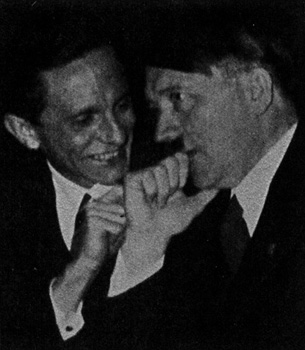 |
If crusaders like Squyres and Greenberg are allowed to spread their
mendacities unhindered, the victory will surely go them. That such a profound question as "are we alone?" is being reduced to character attacks and scientific demagoguery is a massive indictment of the weakness of the "club's" case. If Hoagland is wrong, then let him be proved wrong, with a fair test and by the same rules extended to those in the "club". |
"Oh what a tangled web we weave, when first we practice to deceive ... which only goes to show, we need more practice."
This web is a wondrous and dangerous tool. We must hold those using it to the same standards of integrity that we expect of the practice of science. So far, it has not achieved this wonderful potential. In the hands of the likes of Squyres and Greenberg, it never will. Let's not let the history of this investigation get any more Orwellian than it already has.
And shame on both of you.
Copyright © 1998 MICHAEL BARA AND THE ENTERPRISE MISSION
- Mallove, Eugene - "Fire from Ice"
- https://www.scientificmethod.com/10e.html
- "A Key to the Mystery of Comet Origins" The Enterprise Mission
- "Dr. Malin's False Teeth".
- "The McDaniel Report". Chapter 8, page 147.
- John F. Kennedy's "Grand NASA Plan" Part One
- [www.lunaranomalies.com/czarnik]
- [Link to Von Braun's Service Record]
- NASA Space Act - The Enterprise Mission
- MSN UFO Forum
- 6/12/98
Subject: Re: No SPSR Oral Presentation at AGU Meeting
Date: Fri, 12 Jun 1998 08:10:46 -0500
Newsgroups:msn.onstage.watchfire.bbs
References: 1 , 2 , 3" Let's get this straight. Hoagland did NOT discover the anamolies at Cydonia. He did NOT do the computations, the scientific peer received papers throughout the years."
- "The Monuments of Mars, A City on the Edge of
Forever", R.C. Hoagland, 1987, Chapter 2, "Discovering the
City", pages 13-28.
"The Martian Enigma's, A Closer Look" Mark J. Carlotto, 1991, pages 7, 23-30.
"The McDaniel Report". Chapter 4, pages 62-80. - "The Message of Cydonia" - The Lunar Anomalies Homepage (www.lunaranomalies.com)
- Cassen et-al. "Is there Liquid Water on Europa?", Geophysical Research Letters, vol. 6, Sept. 1979, p. 731-734.
- Enterprise Mission Web Site
- Enterprise Mission Web Site
- Toronto Star article, April 13, 1997, Context Section, page F8.
- "On the Habitability of Europa", Icarus, vol56, Nov. 1983, p.246-254

